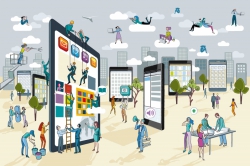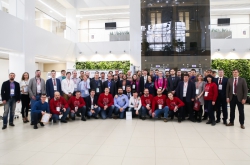Technologies are now constantly finding new areas of application. More importantly, we can see that it takes less and less time for them to integrate. For instance, on the US market, new technologies are adopted in no more than five to six years.
The way companies work changes, too. Over the years, 500 Startups has financed more than seven hundred startups all over the world. We’ve worked with a great number of companies at different stages of development. The way we approach them has changed, as well.
When working with a company in the early stages, it is necessary to keep in mind the many issues and challenges you will face. Yet, if you also look deeper, you might see that these challenges are all directly related to the global state of things; the issues at their core are as old as time itself. Ageing of the population, global demographic changes – these things have an effect on the market environment. This process goes both ways: at one point, the emergence of mobile devices had changed our world completely. These are very simple examples, but they show how global trends can radically change the way companies work.

500 Startups. Credit: 500.co
Another important question is: what effect does time have and what are the main driving forces behind a company’s success? At 500 Startups, we’ve analyzed the various factors of success and business models. What’s interesting is that, looking at the business models from the 90’s, 00’s and even the 10’s, it becomes very clear how time has an effect on their development. There is a very clear, simple conclusion here: if you didn’t react to a challenge in time, you’re gone from the market.
I believe there are several global areas of work which are currently experiencing major growth.
Real estate
Investments here are growing at a really high pace and, if you look at how the industry has been developing the past few years, you’ll see the amount of investment that goes into it. On the other hand, when we studied this market, we noticed that the major players – who work not with the consumers, but in B2B – aren’t very eager to change and use new technology. Now is a good chance for someone to remedy that.
Fintech
The 2008 financial crisis hit the banking system hard, making consumers less trusting of traditional banks. This, among other things, made it impossible for them to keep developing and working in the old paradigm. On the other hand, we must understand that the financial industry offers a wide range of opportunities, some of which even the major companies sometimes can’t see. Loans, various personal finance management formats – these are just some of the many solutions that new companies are working on.

IBM's X-Force Command, a cutting-edge cybersecurity facility. Credit: ibm.com
Cybersecurity
Investments here are also growing. For instance, in the recent years one of the biggest investors in cybersecurity was Israel. Of course, there are highs and lows, but the field remains quite steady overall. Besides, the issues of data security and anti-attack measures are still relevant. Still, I believe that, despite its stable state, the industry as it is today is bound to decline. To develop further, it needs new solutions.
Blockchain
Undoubtedly one of the most popular technologies of late. I won’t repeat all the advantages that blockchain offers – I’ll only note that it is one of the more clear signs that even the way technologies are introduced is changing. They are becoming less centralized; we are moving away from PCs and mobile devices to data chips stored under our skin.
As for cryptocurrencies, which has also been a hot topic for some time, I believe that we are still at a very early stage of their development. Many are prone to overhype their short-term effects. But nobody is talking about what’s going to happen in ten years. I, however, believe that that is the most interesting part.

Open Innovations Forum. Credit: http://forinnovations2017.tassphoto.com
99% of ICOs right now are scams and we have to be careful. Think back to how many companies like Google and Amazon there were in the 90’s. Where are they now? They’re gone and only the giants have survived. The same might happen here, as well: most will die out, but those that stay are bound to make a breakthrough. We have to be careful, yet keep in mind that though some are "bubbles", others present new opportunities.
EdTech
There are many factors that promise a bright future to this industry. On the one hand, there are the reduced costs of consumer goods, on the other – the still-high cost of education, like in the US, for instance. Even though the education sector in many countries is in need of better regulation, I think that, in the next decade, we’ll see some development in EdTech as well.

Digital mole diagnostics. Credit: news-forpeople.com
Digital Healthcare
USA spends 10% of its GDP on digital healthcare. Expenses related to the issues of ageing are growing. We see more technologies like digital diagnostics being integrated. Of course, this industry still needs refinement – there are questions to be solved regarding legislative control. What opportunities are there for startups? Many are still unsatisfied with the functionality and interfaces of such programs. Companies are starting to emerge that seek to offer better solutions and fix the mistakes of their predecessors.
Biomedicine, gene manipulation, pharmacology
These are the areas which I also believe are at the very start of their journey. Perhaps we’ll need more than a decade to fully understand what awaits them in the future. But, in order to release a drug into the market, it has to go through years of pre-clinical and clinical tests. This process may take up to ten years. Even now, with the tools that we’ve got, we can speed it up. The emergence of more and more data and data analysis methods means that we can get more precise results while spending a lot less less time and resources.

Agricultural drone. Credit: e-agriculture.org
Agricultural technology
Today, the world’s population exceeds seven billion; in the coming decades, it is expected to reach nine billion. There are more people now, but less fertile soil, and less and less people are interested in agricultural work. I think the issues here can be solved by bringing together experts from all over the world and letting them share their best practices and experience. This will improve the results and the market capacity.





